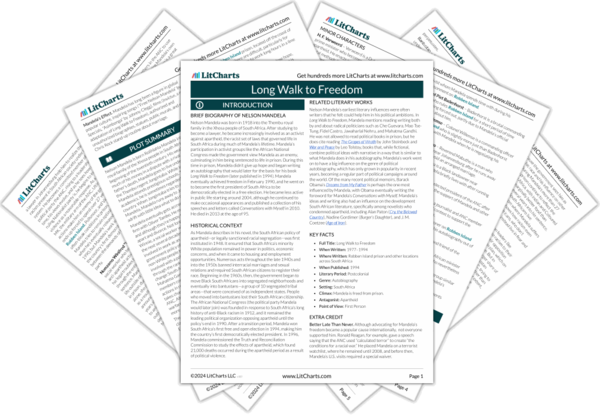Apartheid Quotes in Long Walk to Freedom
Malan’s platform was known as apartheid. Apartheid was a new term but an old idea. It literally means “apartness” and it represented the codification in one oppressive system of all the laws and regulations that had kept Africans in an inferior position to whites for centuries.
The government saw the campaign as a threat to its security and its policy of apartheid. They regarded civil disobedience not as a form of protest but as a crime, and were perturbed by the growing partnership between Africans and Indians. Apartheid was designed to divide racial groups, and we showed that different groups could work together. The prospect of a united front between Africans and Indians, between moderates and radicals, greatly worried them.
The bantustan system had been conceived by Dr. H. F. Verwoerd, the minister of native affairs, as a way of muting international criticism of South African racial policies but at the same time institutionalizing apartheid. The bantustans, or reserves as they were also known, would be separate ethnic enclaves or homelands for all African citizens. Africans, Verwoerd said, “should stand with both feet in the reserves” where they were to “develop along their own lines.” The idea was to preserve the status quo where three million whites owned 87 percent of the land, and relegate the eight million Africans to the remaining 13 percent.
Although we were kept together, our diet was fixed according to race. For breakfast, Africans, Indians, and Coloureds received the same quantities, except that Indians and Coloureds received a half-teaspoonful of sugar, which we did not. For supper, the diets were the same, except that Indians and Coloureds received four ounces of bread while we received none. This latter distinction was made on the curious premise that Africans did not naturally like bread, which was a more sophisticated or “Western” taste. The diet for white detainees was far superior to that for Africans. So color-conscious were the authorities that even the type of sugar and bread supplied to whites and nonwhites differed: white prisoners received white sugar and white bread, while Coloured and Indian prisoners were given brown sugar and brown bread.
I did not regard the verdict as a vindication of the legal system or evidence that a black man could get a fair trial in a white man’s court. It was the right verdict and a just one, but it was largely as a result of a superior defense team and the fair-mindedness of the panel of these particular judges.
In planning the direction and form that MK would take, we considered four types of violent activities: sabotage, guerrilla warfare, terrorism, and open revolution. For a small and fledgling army, open revolution was inconceivable. Terrorism inevitably reflected poorly on those who used it, undermining any public support it might otherwise garner. Guerrilla warfare was a possibility, but since the ANC had been reluctant to embrace violence at all, it made sense to start with the form of violence that inflicted the least harm against individuals: sabotage.
I entered the court that Monday morning wearing a traditional Xhosa leopard-skin kaross instead of a suit and tie. The crowd of supporters rose as one and with raised, clenched fists shouted “Amandla!” and “Ngawethu!” The kaross electrified the spectators, many of whom were friends and family, some of whom had come all the way from the Transkei. Winnie also wore a traditional beaded headdress and an ankle-length Xhosa skirt.
I had chosen traditional dress to emphasize the symbolism that I was a black African walking into a white man’s court. I was literally carrying on my back the history, culture, and heritage of my people.
In jail, all prisoners are classified by the authorities as one of four categories: A, B, C, or D. A is the highest classification and confers the most privileges; D is the lowest and confers the least. All political prisoners, or what the authorities called “security prisoners,” were automatically classified as D on admission. The privileges affected by these classifications included visits and letters, studies, and the opportunity to buy groceries and incidentals—all of which are the lifeblood of any prisoner. It normally took years for a political prisoner to raise his status from D to C.
I have walked that long road to freedom. I have tried not to falter; I have made missteps along the way. But I have discovered the secret that after climbing a great hill, one only finds that there are many more hills to climb. I have taken a moment here to rest, to steal a view of the glorious vista that surrounds me, to look back on the distance I have come. But I can rest only for a moment, for with freedom come responsibilities, and I dare not linger, for my long walk is not yet ended.












